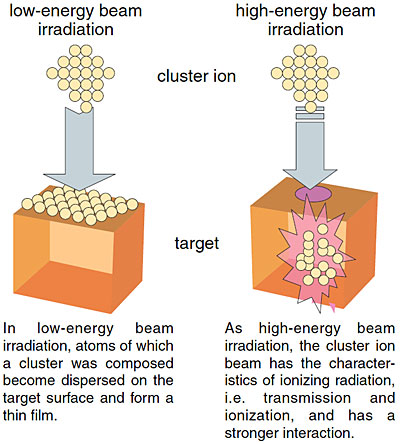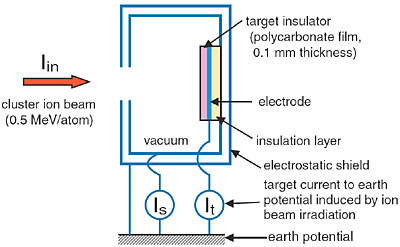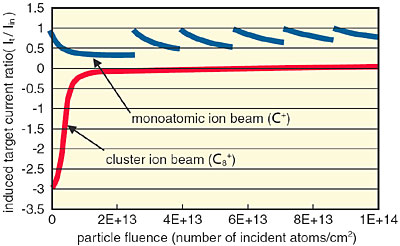A cluster is basically a collection of things of the same kind, growing closely together, just like a cluster of grapes. Microscopically, it may be a nanoparticle in which several atoms or molecules are gathered to form a large mass. Cluster ions, meaning charged clusters (Fig.6-16), carry a large number of atoms or molecules with a relatively small amount of charge efficiently and in the form of beams are an effective means of forming various surface structures on materials. In recent years, low-energy cluster ion beam technology has attracted interest as an originally Japanese technique for nano-scale materials processing. High-intensity cluster ion beams can easily be produced and applied to the processing of various materials. However, they do not exhibit the characteristics of ionizing radiation because of their low energy.
We have developed techniques for generation and acceleration of MeV cluster ion beams and have begun research on ion beam irradiation effects due to particle transmission and subsequent strong interactions with matter. We have succeeded in generating 10 species of cluster ions and accelerating them up to 6 MeV by improving and optimizing the operating conditions for a 3 MV tandem accelerator and its ion source. This laboratory is now the only cluster ion beam irradiation facility in the country which provides intense beams of more than one nanoampere, thus playing a pioneering role in the development of applications. As a result of application studies, a number of new phenomena induced by cluster ion beam irradiation have been found up to now, including electrical effects in solid insulators (Fig.6-17), chemical modification effects, and elementary processes in the interaction of cluster ions with matter.
Fig. 6-18 shows the change of the target current with particle fluence (number of incident atoms/cm2) associated with monatomic and cluster ion beam irradiation in vacuum, obtained with the experimental arrangement in Fig. 6-17. The target current reflects charge behavior of the target insulator. In monatomic ion beam irradiation, accumulation of excess charge and subsequent electric breakdown are repeated in the target under irradiation, but excess charge does not accumulate under cluster ion beam irradiation, and a relatively large amount of secondary positive charge is emitted from the target. These results suggest that cluster ion beam irradiation is effective for the avoidance of electric breakdown resulting from accumulation of excess charge. The latter is a technical problem encountered in studies of ion implantation into solid insulators.
|


